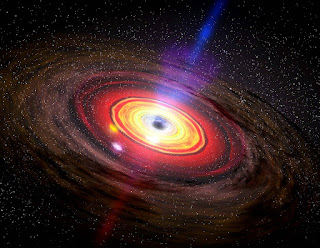Black Holes: The Ultimate Cosmic Conundrum
Black holes are among the most mysterious and awe-inspiring objects in the universe. They are regions of space where gravity is so intense that not even light can escape, making them invisible to the naked eye. However, their presence can be detected through the effects of their gravity on nearby matter.
Black holes
are formed when massive stars reach the end of their lives and collapse
under their own gravity, creating a point of
infinite density called a singularity surrounded by a boundary known as the
event horizon. Beyond the event horizon, anything that enters a black
hole is pulled towards the singularity and cannot escape.
There are
three main types of black holes: stellar, intermediate, and supermassive.
Stellar black holes form from the collapse of
massive stars and have masses several times that of the sun.
Intermediate black holes are thought to bridge the gap between stellar and
supermassive black holes and have masses between 100 and 100,000 times that of
the sun. Supermassive black holes are found at the
centers of most galaxies and have masses millions to billions of times that of
the sun.
The study
of black holes has advanced our understanding of the universe in many ways. For example, they have
revealed new insights into the nature of gravity
and the laws of physics, and they have inspired a new generation of scientists and
researchers to explore the mysteries of the universe.
Despite the
advances in our understanding, black holes still pose many questions and
challenges to our current understanding of physics. For example, the nature of the singularity and what happens inside the
event horizon remain major areas of research and debate.
In
conclusion, black
holes are truly remarkable objects that continue to
challenge and inspire scientists and researchers alike. Their study has
advanced our understanding of the universe and has the potential to uncover
many more secrets in the years to come.
Ali Faizan Ansari





No comments:
Post a Comment